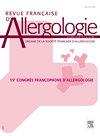Evaluation of neutrophil-lymphocyte, platelet-lymphocyte ratio changes in patients with acute and chronic urticaria
IF 0.3
4区 医学
引用次数: 0
Abstract
Study objective
This study aimed to evaluate the changes in inflammatory markers, specifically neutrophil-to-lymphocyte ratio (NLR) and platelet-to-lymphocyte ratio (PLR), in pediatric patients with acute and chronic urticaria. The objective was to compare these inflammatory indices between patients with acute urticaria, chronic urticaria, and healthy controls to determine whether they can be used as potential biomarkers for the evaluation of urticaria.
Patients and methods
The study included 200 participants: 100 with acute urticaria, 50 with chronic urticaria, and 50 healthy controls, all aged 0–18 years. Blood samples were taken to calculate NLR, PLR, systemic immune-inflammation index (SII), and other related indices. Specific allergen sensitivities were also evaluated using specific IgE tests and skin prick tests.
Results
The study found significant differences in NLR, PLR, and SII between the acute and chronic urticaria groups and the control group. NLR and PLR were significantly higher in the chronic urticaria group, suggesting ongoing inflammation. No significant difference was found in monocyte, platelet, eosinophil, and basophil counts.
Conclusion
The findings suggest that NLR, PLR, and SII could be potential biomarkers for assessing the inflammatory response in urticaria, particularly in differentiating between acute and chronic forms. However, further research is needed to confirm the clinical utility of these markers for routine evaluation in urticaria patients.
急性和慢性荨麻疹患者中性粒细胞-淋巴细胞、血小板-淋巴细胞比值变化的评价
本研究旨在评价急性和慢性荨麻疹患儿炎症标志物,特别是中性粒细胞与淋巴细胞比值(NLR)和血小板与淋巴细胞比值(PLR)的变化。目的是比较急性荨麻疹患者、慢性荨麻疹患者和健康对照者之间的这些炎症指标,以确定它们是否可以用作评估荨麻疹的潜在生物标志物。患者和方法该研究包括200名参与者:100名急性荨麻疹患者,50名慢性荨麻疹患者和50名健康对照,年龄均为0-18岁。取血计算NLR、PLR、全身免疫炎症指数(SII)等相关指标。特异性过敏原敏感性也通过特异性IgE试验和皮肤点刺试验进行评估。结果急性、慢性荨麻疹组NLR、PLR、SII与对照组比较差异有统计学意义。慢性荨麻疹组NLR和PLR显著升高,提示持续炎症。单核细胞、血小板、嗜酸性粒细胞和嗜碱性粒细胞计数无显著差异。研究结果表明NLR、PLR和SII可能是评估荨麻疹炎症反应的潜在生物标志物,特别是在区分急性和慢性形式方面。然而,需要进一步的研究来证实这些标志物在荨麻疹患者常规评估中的临床应用。
本文章由计算机程序翻译,如有差异,请以英文原文为准。
求助全文
约1分钟内获得全文
求助全文
来源期刊

Revue Francaise d Allergologie
Medicine-Immunology and Allergy
自引率
33.30%
发文量
349
期刊介绍:
La Revue Française d''Allergologie : un véritable forum pour faire connaître des travaux originaux et permettre la diffusion de l''information auprès de toutes les spécialités concernées par les pathologies allergiques. La Revue Française d''Allergologie (8 numéros par an) est au carrefour de nombreuses spécialités - dermatologie, pédiatrie, ORL, pneumologie, ophtalmologie, médecine interne - qui, toutes, ont à traiter des maladies allergiques. Les symptômes des allergies fondés sur des mécanismes communs sont le plus souvent associés et se succèdent chez un même patient. En forte progression depuis 20 ans, les maladies allergiques sont dans l''attente de perfectionnements et d''avancées thérapeutiques qui permettront aux nombreux patients qui en sont atteints de mieux vivre avec leurs allergies. La Revue Française d''Allergologie se veut donc un véritable forum de discussions et d''échanges entre tous les spécialistes confrontés aux pathologies
 求助内容:
求助内容: 应助结果提醒方式:
应助结果提醒方式:


